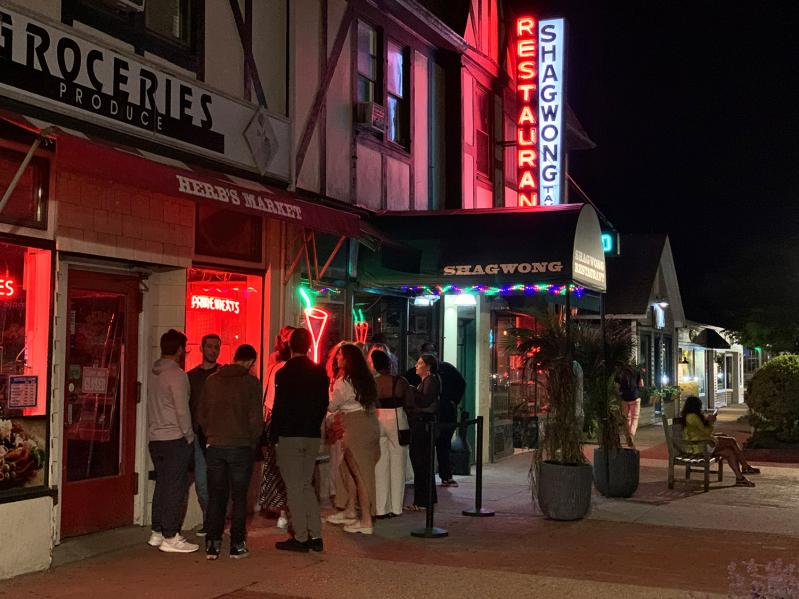It was never going to be easy for the East Hampton Town Zoning Board of Appeals to rule against the Shagwong Tavern in Montauk.
Since last summer, when the popular tavern was caught up in an enforcement sweep that led to a determination by Ann Glennon, then the chief building inspector for the town, that it was operating as a nightclub, the board has held two emotional public hearings, received two different determinations from Ms. Glennon, and been accused by the Shagwong’s lawyer, Jon Tarbet, in a well-known tabloid of attempting to outlaw dancing in the town.
In February, the board split 3 to 2 to uphold Ms. Glennon’s determination. The week after, it decided more information was needed, which produced Ms. Glennon’s clarification of her original determination, and a second public hearing in May. After wrestling with language and the weight of history, Tuesday night’s vote on the application was split again, this time in favor of the Shagwong.
Mr. Tarbet’s strategy of turning out Montauk locals to support the Shagwong at the May hearing seemed to have proven effective in turning the vote in the tavern’s favor.
Ed Johann, a zoning board member, said that while most of the comments were heartfelt, they didn’t necessarily shift his vote. However, comments by Shawn Hewitt, Dan Stavola, and Jason Behan, an owner of the Shagwong, made it clear to him that dancing throughout the restaurant was “a pre-existing condition that could exempt the Shagwong from being considered as having added a new use.”
He switched his February vote and sided with Roy Dalene, the board chairman, and Joan McGivern, another board member, to overturn Ms. Glennon’s determination. Theresa Berger and Denise Savarese held firm to their February votes to uphold Ms. Glennon’s determination.
“When the tables and chairs are removed from an area by the bar, it’s a recognition of a pre-existing nonconforming use,” said Ms. Savarese. “Once you start to expand into the center, moving tables and chairs outside, you have increased the nonconforming condition and you have expanded a use that you don’t legally have.”
Even the board members who voted with the tavern were uneasy with the safety implications.
“The problem for me,” said Mr. Johann, “I lend tacit approval to Shagwong being allowed to operate as . . . a nightclub and fill their space with paying customers, none of whom benefit from the safety measures that would be enforced if they were forced to comply with the regulations established by the town for nightspots and clubs.”
Ms. McGivern echoed Mr. Johann’s sentiments. “I’m very sympathetic to the enforcement challenges,” she said. “I am troubled by the safety issues, but I don’t know that it’s within our jurisdiction to say to the owner ‘please put in a sprinkler system.’ That would be a request.”
“Safety trumps anything. You can’t pre-date safety,” said Mr. Dalene.
“But safety isn’t part of our jurisdiction,” said Ms. McGivern.
“Occupancy, yes, it is,” said Mr. Dalene. He argued that if the tavern was sometimes operating as a nightclub, that it had to respect nightclub regulations during those times, since restaurants and bars are allowed a much higher capacity than a nightclub, and not complying with the alternate regulations could endanger patrons with overcrowding.
Often, it was unclear what the board was agreeing to, what questions Ms. Glennon’s determinations asked of them, and once again, what defined the Shagwong. The board stopped and started, unable to put into words the practical application of its decision.
“I think we say both times the question presented to us doesn’t allow for an easy answer, and what we can say is what they’ve established is that there was a pre-existing use as a bar and a restaurant with music and dancing,” said Ms. McGivern.
“Their occupancy exceeds; it doesn’t matter,” said Mr. Dalene, pausing for a long moment as he thought. “It exceeds the requirement of a nightclub of 100 persons requiring them to have sprinklers. That’s the life safety issue that trumps any code.”
John Jilnicki, a town attorney, offered a new perspective. If they started dancing after hours when they were no longer operating as a restaurant, and they went over the 100 occupants allowed as a nightclub, “You can’t exempt them from complying with New York State Fire Prevention Code. You don’t have that authority. Only the state could give that variance,” he explained.
“Oh, that’s interesting,” said Mr. Dalene, sensing a breakthrough.
Ms. McGivern tried again. “We could say, notwithstanding our decision, nothing exempts them from fire code and applicable provisions of the fire code.”
“We agree they’re a restaurant and bar,” said Mr. Dalene. “We agree that they [have] pre-existing dancing and music. Any time they are acting as a nightclub they must comply with provisions of a nightclub, and occupancy and fire code, we can condition this decision that they meet, in any case, fire code as approved by the town fire marshal.”
Nonetheless, even though it was now clear what they all agreed to, the hearing ended with a question that had no clear answer.
“Counsel, are we even close to being all right with all of this?” asked Mr. Johann.
“It looks like it’s 3-2,” answered Mr. Jilnicki.
In another decision, which was far easier for the board, it ruled unanimously to uphold Ms. Glennon’s determination that Sand Highway in East Hampton could not self-designate as a nature preserve. Additionally, it ruled that town code was clear that Sand Highway’s mining activities could not penetrate the groundwater without a natural resources special permit.




